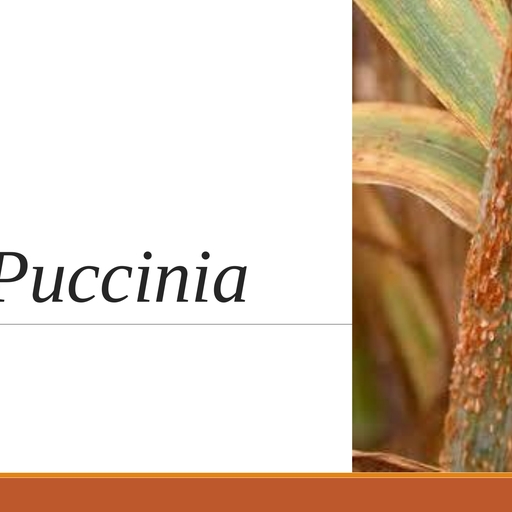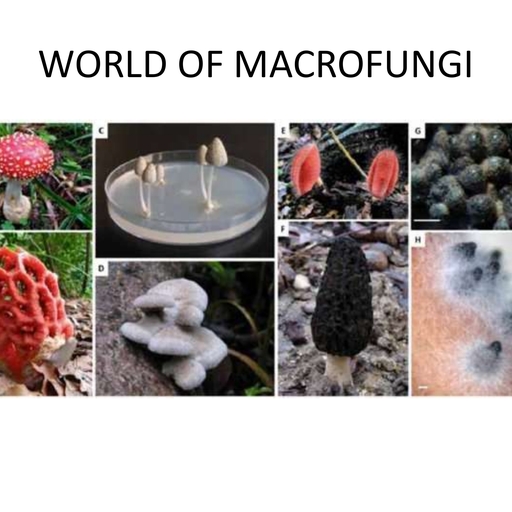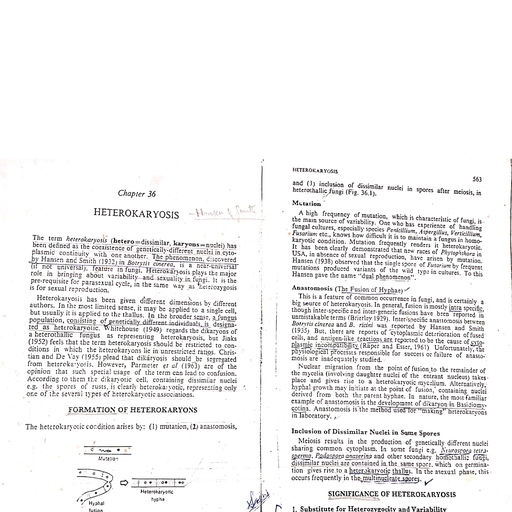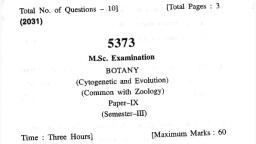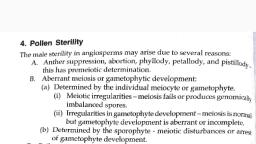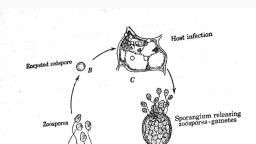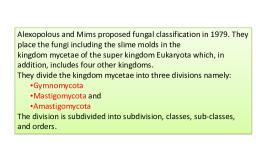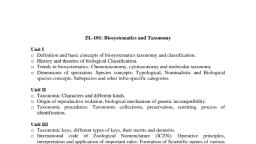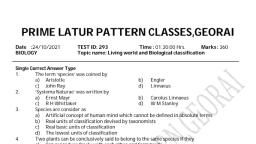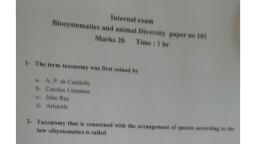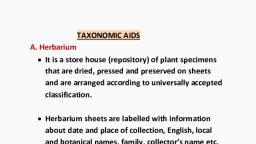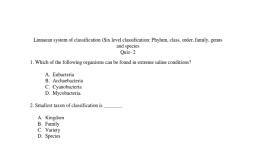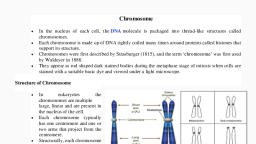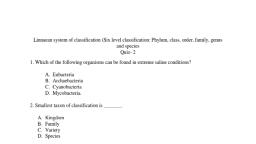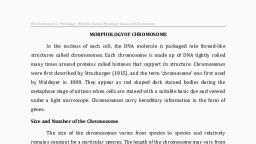Page 2 :
Post Mendelian Approaches, The complete knowledge of taxonomy is possible only when a synthetic approach, in the, light of the principles of various disciplines, is applied. These disciplines (cytology,, palynology, embryology, ecology, genetics etc.) have played a significant role in plant, taxonomy. The old ideas of classification and phylogeny of the plants have changed, enormously because of the newer aspects of taxonomy such as biosystematics,, cytotaxonomy, chemotaxonomy, molecular taxonomy, etc., , An Introduction to:, , , Genecology- The term genecology was applied by Turesson(1923) to the study of, the infra specific(occurring within or affecting all members of a species; at a, taxonomic level below that of species, e.g. subspecies, cultivar, etc.) variation of, plants in relation to environment. As a branch of ecology it studies genetic variation, of species and communities compared to their population distribution in a particular, environment. It is primarily concerned with species and its genetically variant, subdivisions with their position in nature. Thus genecology is the study of the, genotypic and phenotypic variation of species in relation to the environments in, which they occur., , Genecology merges into taxonomy when it aims to systematize for classificatory purposes, patterns of infraspecific variation., Taxonomists have divided taxononomy into two types:, 1. Classical Taxonomy- The oldest form of taxonomy is called classical taxonomy or, orthodox taxonomy. It is related to the description, naming and classification of the, animals and plants based on the morphological features., 2., , Experimental Taxonomy- It is based on all the possible character and relevant, data obtained from the study of various aspects of plants such as anatomy, ecology,, embryology, phytochemistry, phytogeography, palynology etc. It not only implies, the use of experimental procedures, but the taxonomic study of organisms from the, standpoint of population rather than individuals, and of the evolutionary processes, which occur within populations., , , , Cytotaxonomy- Utilization of the characters and phenomena of cytology (study of, the cell) for the explanation of taxonomic problems is referred as cytotaxonomy., , The characteristics of the chromosomes, which have proved to be of taxonomic value,, include, - Chromosome number-Variation or constancy in the chromosome number-, within taxa of, different categories, prove to be important character for taxonomic grouping., The chromosome number in some plants remains constant in all species, e.g. all species of, Pinus possess n=12 chromosomes. These numbers prove useful in kniwing a particular, genus., - Chromosome size- The chromosome size has been very useful in understanding, relationships in several taxa. Among monocots, the members of Zingiberaceae possess, small chromosomes, of Iridaceae small to medium-sized, of Amaryllidaceae large-sized,, while those of Liliaceae possess chromosomes of varying sizes.
Page 3 :
- Chromosome morphology- Relative length of the arms of the chromosomes, position of, the centromere, presence of satellites, etc.are some characters of taxonomic significance., - Chromosome behaviour at meiosis- Significant taxonomic information may be obtained, by the study of the behaviour of the chromosomes during meiosis. Abnormalities in, meiosis, such as non-pairing, crossing over, unequal interchanges or translocations, bridge, formation, lagging chromosomes, etc.have all proved to be of systematic value., Examples of role of cytology in taxonomy:, , , The presence of 25 small and 5 large chromosomes in Yucca and Agave justified, , their placement in one single family Amaryllidaceae, as done by Hutchinson., , , In the subfamily Bambusoideae of Poaceae n=12, and in the subfamily Poideae n=7, , indicating that the chromosome number have proved to be of taxonomic utility also at the, subfamily level., , , Delimitation of the tribes in Asteraceae has been done on the basis of chromosome, , numbers., , , Biosystematics- An integrative and unifying science through which organisms are, discovered, identified, named and classified with their diversity, phylogeny, spatial, and geographical distributions. It is a branch which uses the data from many, disciplines like morphology, anatomy, cytology, genetics, palynology, embryology,, ecology, plant geography, phylogeny, physiology, phytochemistry, evolution and, paleobotany., , Biosystematics is the taxonomic application of genecology (is the study of the genotypic, and phenotypic variation of species in relation to the environments in which they occur). It, is the union of taxonomy and genetics. Biosystematics is mainly concerned with genetical,, cytological and ecological aspect of taxonomy., In the sense of experimental taxonomy it provides data on variations, adaptations, and, evolutionary dynamics of populations and species, , , Palynotaxonomy- Study of pollen and spores is called palynology. The shape and, symmetry of pollen grain, the architecture of its wall, exine stratification, structure,, type, number, position, shape and structure of its aperture are some of the basic, characters which prove useful at all taxonomic levels., , - Monosulcate pollen grains (boat shaped in outline and possess one long germinal furrow, and germinal aperture) are characteristic of primitive dicots, several monocots and cycads., Tricolpate pollen grains (globose in shape and have three germinal apertures) are, characteristic of advanced dicots., - Stenopalynous or unipalynous taxa (pollen type is constant, monoporate aperture and, smooth exine surface) e.g. Poaceae, Eurypalynous or multipalynous (pollen type varies in size, aperture, exine stratification, etc.) e.g. Euphorbiaceae, - NPC system: The classification of pollen is based on the number- position-character, analysis, called NPC system. Palynological studies suggest that the taxa with the same, general NPC formula be grouped together, and those showing different NPC, separately., - Size and shape of pollen are important diagnostic characters. The shape may be circular,
Page 4 :
triangular, etc. in polar view whereas it may be prolate (of a spheroid lengthened in the, direction of polar diameter, spheroidal etc., - Apertures may be proximal (gymnosperms and monocots), distal (pteridophytes), zonal, (dicots)., - Exine sculpturing may be of depression type or excrescence type., - Pollen associations, such as their arrangement in tetrads, presence of pollinia, etc. are, characteristic of several angiospermic families., - Number of nuclei in the pollen grains at the time of their release is a valuable taxonomic, and phylogenetic character., Examples of role of palynology in taxonomy:, , , Pollen grains are associated in tetrads in several families of dicots (Annonaceae,, Mimosaceae) and monocots (Cyperaceae). In Asclepiadaceae and Orchidaceae,, they form pollinia., , , , The exine pattern is useful in recognising different species of a genus., , References, 1. Sharma, O.P. (2010) Plant Taxonomy, Tata McGraw Hill Education Private Limited,, New Delhi., 2. Stace, Clive. (1991) Plant Taxonomy and Biosystematics, Cambridge University, Press, England., https://books.google.com
